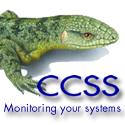Solution now includes additional monitors to help BRMS users manage their backup processes.
QSystem Monitor (QSM), the performance monitoring and reporting solution from CCSS, now includes additional monitors to help BRMS users manage their backup processes more effectively on IBM Power Systems and System i platforms. The two new commands focus on the message log and media status of the BRMS (Backup, Recovery, Media Services) application and complement the existing BRMS monitoring features of QSystem Monitor that surround BRMS jobs, subsystems, job queues, library attributes and file management.
The first new command, MONCHKBML (Check BRMS Message Log), allows users to monitor the total number of a nominated message currently present in the BRMS log. There are many critical messages generated by BRMS that if missed, could impact the important backup process with an unnecessary delay. Through QSM’s MONCHKBML command, users can identify these types of critical messages, for example, ‘cartridge not available’ and take the necessary action before this condition impacts the process. Individual thresholds can also be assigned to each message according to the requirements of that particular user environment. When setting up their requirements, users can select from a choice of three different collection intervals: *MONITOR–where the program will use the same collection interval as the monitor, *DELAY–where the program will wait for a specified number of seconds between collections, and *RSMTIME–where the program will wait until a specified time of day to run. Examples of other types of critical messages that can be selected for monitoring under the MONCHKBML command include ‘cartridge not found’, ‘volume ID does not match cartridge ID’ or ‘volume is write protected.’
The second new command, MONCHKBMS (Check BRMS Media Status), allows the user to monitor the total number of tapes in a specified status: by location, container, media class, system or type of value. There are three value types to choose from: *TOTACT–which returns the total number of active volumes, *TOTEXP–which returns the total number of expired volumes, and *TOTVOL–which returns the total number of volumes. As with MONCHKBML, thresholds can be assigned for each message but in this case, these operate on an inverted threshold scale to show if a value is less than it should be. For example, if there were fewer than the required number of tapes needed for a backup on a particular system, the actual number available (e.g. 20) and the required number (e.g. 25) would both appear in the message. When defining the parameters of these messages on the system, users can choose from the same three collection interval options (*MONITOR, *DELAY or *RSMTIME) as with the MONCHKBML command.
QSystem Monitor users benefit from a visual representation of their BRMS monitoring capabilities via the online console (refer to BRMS Screenshot.jpg). In an ‘All Systems’ view, a dedicated bar is seen for each critical message, grouped according to the commands. For example, one view would show the nominated message ID’s in the BRMS log. There may be four ID’s in total that have been defined but only one active alert each for two of those ID’s–the other inactive ID’s may be shown as green bars with a ‘0’ value attached, indicating those monitors are running but currently there is no activity. Where there is activity, the bar will turn red, bringing it to the attention of the operator with a value as to how often this message has appeared. From here they can view a separate window of the current thresholds. This will give them all the critical information relating to that red bar in an instant including a full message description, date/time, severity, values and related system details.
Paul Ratchford, Product Manager for CCSS says, “BRMS users are by definition a group with a firm appreciation for the importance of tracking and managing their data and the media resources they use to do that. These new commands extend the benefits of our own pro-active approach to system management into the BRMS domain. BRMS users don’t have to watch and manage that critical backup process at every stage. If something’s not in place or messages are coming through to let them know something’s awry, there’s no chance they’ll miss that. It’s a case of increasing visibility for greater efficiency and giving managers sufficient time to respond to issues before they impact important processes. This translates as real value to the environment as it reduces the likelihood of the types of problems that tend to eat up people’s time and resources in solving them.”
For more information on QMessage Monitor, please visit: http://www.ccssltd.com/products/qsystem-monitor/
About CCSS
CCSS develops, supports and markets IBM i (on Power Systems & System i servers) performance monitoring and reporting, message management and remote management solutions. An Advanced IBM Business Partner, CCSS develops powerful solutions to support some of the world’s most demanding IBM i environments across many industries including insurance, banking, pharmaceutical and manufacturing. Existing customers that rely on CCSS’s feature-rich solutions include leading organizations such as Volvo, Mattel, Newell-Rubbermaid, The Royal Bank of Scotland, Siemens Healthcare, RWE npower and Waterstone’s.
CCSS is headquartered in Gillingham, Kent, UK with key regional headquarters in Raleigh, North Carolina, USA; Bonn, Germany and Makati City, Philippines together with a global agent network spanning Austria, Portugal, the Netherlands, Switzerland and Sweden.





















 More than ever, there is a demand for IT to deliver innovation. Your IBM i has been an essential part of your business operations for years. However, your organization may struggle to maintain the current system and implement new projects. The thousands of customers we've worked with and surveyed state that expectations regarding the digital footprint and vision of the company are not aligned with the current IT environment.
More than ever, there is a demand for IT to deliver innovation. Your IBM i has been an essential part of your business operations for years. However, your organization may struggle to maintain the current system and implement new projects. The thousands of customers we've worked with and surveyed state that expectations regarding the digital footprint and vision of the company are not aligned with the current IT environment. TRY the one package that solves all your document design and printing challenges on all your platforms. Produce bar code labels, electronic forms, ad hoc reports, and RFID tags – without programming! MarkMagic is the only document design and print solution that combines report writing, WYSIWYG label and forms design, and conditional printing in one integrated product. Make sure your data survives when catastrophe hits. Request your trial now! Request Now.
TRY the one package that solves all your document design and printing challenges on all your platforms. Produce bar code labels, electronic forms, ad hoc reports, and RFID tags – without programming! MarkMagic is the only document design and print solution that combines report writing, WYSIWYG label and forms design, and conditional printing in one integrated product. Make sure your data survives when catastrophe hits. Request your trial now! Request Now. Forms of ransomware has been around for over 30 years, and with more and more organizations suffering attacks each year, it continues to endure. What has made ransomware such a durable threat and what is the best way to combat it? In order to prevent ransomware, organizations must first understand how it works.
Forms of ransomware has been around for over 30 years, and with more and more organizations suffering attacks each year, it continues to endure. What has made ransomware such a durable threat and what is the best way to combat it? In order to prevent ransomware, organizations must first understand how it works. Disaster protection is vital to every business. Yet, it often consists of patched together procedures that are prone to error. From automatic backups to data encryption to media management, Robot automates the routine (yet often complex) tasks of iSeries backup and recovery, saving you time and money and making the process safer and more reliable. Automate your backups with the Robot Backup and Recovery Solution. Key features include:
Disaster protection is vital to every business. Yet, it often consists of patched together procedures that are prone to error. From automatic backups to data encryption to media management, Robot automates the routine (yet often complex) tasks of iSeries backup and recovery, saving you time and money and making the process safer and more reliable. Automate your backups with the Robot Backup and Recovery Solution. Key features include: Business users want new applications now. Market and regulatory pressures require faster application updates and delivery into production. Your IBM i developers may be approaching retirement, and you see no sure way to fill their positions with experienced developers. In addition, you may be caught between maintaining your existing applications and the uncertainty of moving to something new.
Business users want new applications now. Market and regulatory pressures require faster application updates and delivery into production. Your IBM i developers may be approaching retirement, and you see no sure way to fill their positions with experienced developers. In addition, you may be caught between maintaining your existing applications and the uncertainty of moving to something new. IT managers hoping to find new IBM i talent are discovering that the pool of experienced RPG programmers and operators or administrators with intimate knowledge of the operating system and the applications that run on it is small. This begs the question: How will you manage the platform that supports such a big part of your business? This guide offers strategies and software suggestions to help you plan IT staffing and resources and smooth the transition after your AS/400 talent retires. Read on to learn:
IT managers hoping to find new IBM i talent are discovering that the pool of experienced RPG programmers and operators or administrators with intimate knowledge of the operating system and the applications that run on it is small. This begs the question: How will you manage the platform that supports such a big part of your business? This guide offers strategies and software suggestions to help you plan IT staffing and resources and smooth the transition after your AS/400 talent retires. Read on to learn:
LATEST COMMENTS
MC Press Online